The global casino industry continues to grow in 2025, with 8,108 casinos operating worldwide.
In the U.S., there are 1,011 casinos, and Nevada has the highest number, with 345.
The online casino market is also experiencing substantial growth, with the global online gambling sector projected to have reached $35.01 billion in 2025. At the same time, U.S. online casino revenue was expected to reach $6.29 billion.
Integrating emerging technologies such as artificial intelligence, mobile gaming, and virtual reality enhances the casino experience, making it more personalized and immersive, attracting more players.
This report covers the growth of the casino industry, its significant economic impact, and the challenges it faces as it evolves.
Casino Statistics 2025: Important Takeaways
- The global casino industry has a total of 8,108 casinos operating worldwide.
- In the United States, there are 1,011 casinos.
- Only 13.5% of casino players win.
- Medium-sized casinos typically generate between $100,000 and $500,000 in monthly revenue.
- The average age of U.S. casino visitors in 2024 is 41.9 years.
- Nevada has the most casinos in the U.S., with 345.
- Gambling disorder affects one-sixth of adults and over one-fourth of adolescents who play online casino games or slots.
- U.S. casinos, excluding casino hotels, were expected to generate $21.83 billion in revenue in 2024.
- The online casino market was estimated to reach $35.01 billion in 2024.
- Online casino revenue in the United States was expected to hit $6.29 billion in 2024.
How Many Casinos Are There Worldwide?
There are a total of 8,108 casinos operating worldwide.
This number includes both land-based and online casinos, which are growing rapidly due to technological advancements and evolving consumer preferences.
Source: Statista
How Many Casinos Are There In The United States?
There are 1,011 casinos in the United States.
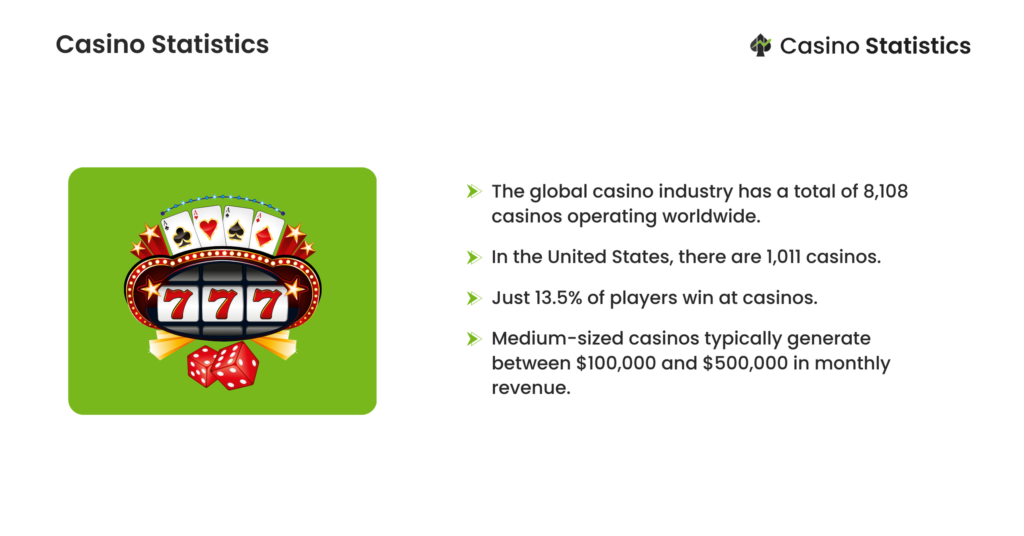
These include land-based and tribal venues, along with a few legally operating online platforms.
The casino industry in the United States significantly impacts the economy, contributing $328.65 billion annually. It also employs around 1.75 million people, covering jobs directly in casinos, such as dealers and managers, and indirectly in related sectors like hospitality and transportation.
Additionally, casinos generate $52.71 billion in tax revenue, which helps fund public services like education, infrastructure, and community programs. Tribal casinos also share their profits with Native communities, helping to support their economic growth and well-being.
Source: American Gaming Association
What Percentage Of People Win At A Casino?
A recent study of 4,222 gamblers revealed that only 13.5% of players win at casinos.
Among these, just 7 individuals managed to win over $150, highlighting the slim chances of significant success in casino games.
On the other hand, the study found that 217 players experienced substantial losses, each losing more than $5,000 during their casino visits. This contrast between occasional winners and frequent losers emphasizes the risks associated with gambling.
The data also suggests a clear trend: the more often a person plays, the lower their chances of winning.
Source: Aceperhead
How Much Does The Average Person Lose At A Casino?
An average person in the United States loses $125 per visit to a casino.
At-risk gamblers tend to lose about $3,000 annually. Casual gamblers, on the other hand, lose roughly $500 per year, reflecting a big difference in spending habits.
In 2023, total gambling spending in the U.S. reached $264 billion, which equates to:
- $788 per capita, considering the entire U.S. population.
- $1,026 per adult, focusing on individuals aged 18 and above legally eligible to gamble.
Source: Quit Gamble, VegasAces
Odds Of Winning At A Casino Slot Machine
The odds of winning a jackpot on a casino slot machine are typically very low, often less than 1 in a million.
The house edge on slot machines can vary based on the game and the casino, but it usually falls between 2% and 15%. This means that, on average, the casino has a significant advantage over the player.
Despite the slim odds of winning big, slot machines remain one of the most popular games in casinos and are also among the most profitable for the casinos themselves.
Source: Investopedia
Average Casino Profit Per Day
A medium-sized casino typically generates between $100,000 and $500,000 per month.
Several factors can influence this, such as the types of games offered—games with higher house edges tend to bring in more money. Also, the level of player activity, like how many users are active and how well the casino retains them, can affect earnings.
The profit margin for online casinos is usually low, ranging from 2% to 10% of the total money players bet. This means casinos typically keep only a small portion of the total amount bet by a player.
In 2021, online casinos collectively generated about $56 million in revenue. With an estimated 3,500 to 4,000 casinos operating then, this totals about $14.9 million per casino or roughly $38,360 per day.
Source: Hollywood Progressive, Slotegrator.
Gender Demographics of Casino Players
Approximately 64% of the gambling population are men, while 36% are women.
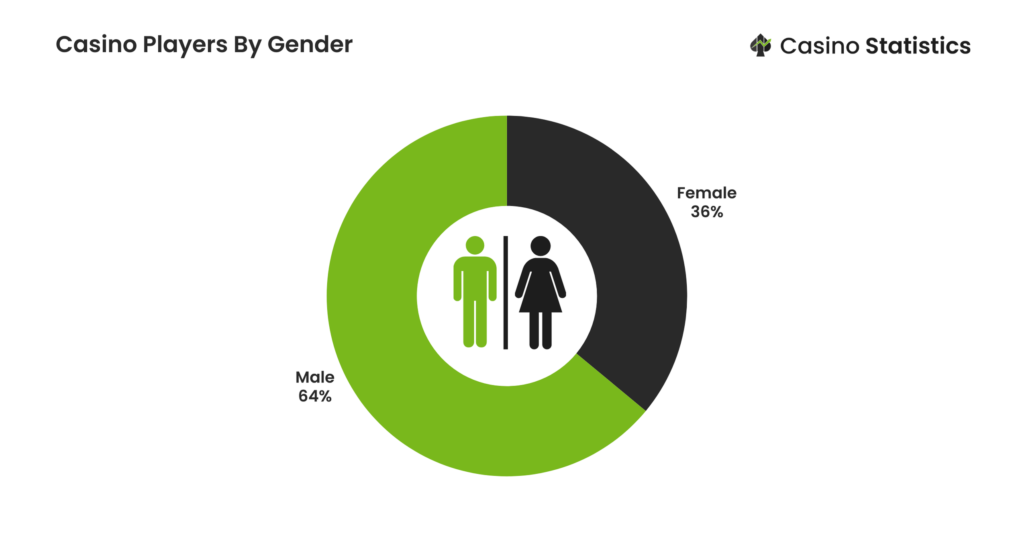
Men are more likely to play casinos than women.
In the United States, this difference is even more pronounced, with 69% of men engaging in gambling compared to only 36% of women. This indicates that men are roughly twice as likely to participate in gambling activities as women.
Source: PlayToday.
Age Demographics of Casino Players
The average age of individuals who visited a casino in the United States in 2024 is 41.9 years.
This marks a slight decrease from 42 years in 2023, continuing a trend of younger visitors over recent years. From 2020 to 2025, the average age dropped by about 1.9 years, from 43.8 to 41.9.
The most notable shift occurred in 2020, when the average age dropped by 5.8 years, from 49.6 in 2019 to 43.8. This could reflect several factors, such as the growing popularity of online casinos and mobile gaming and changes in casino offerings that appeal more to younger audiences.
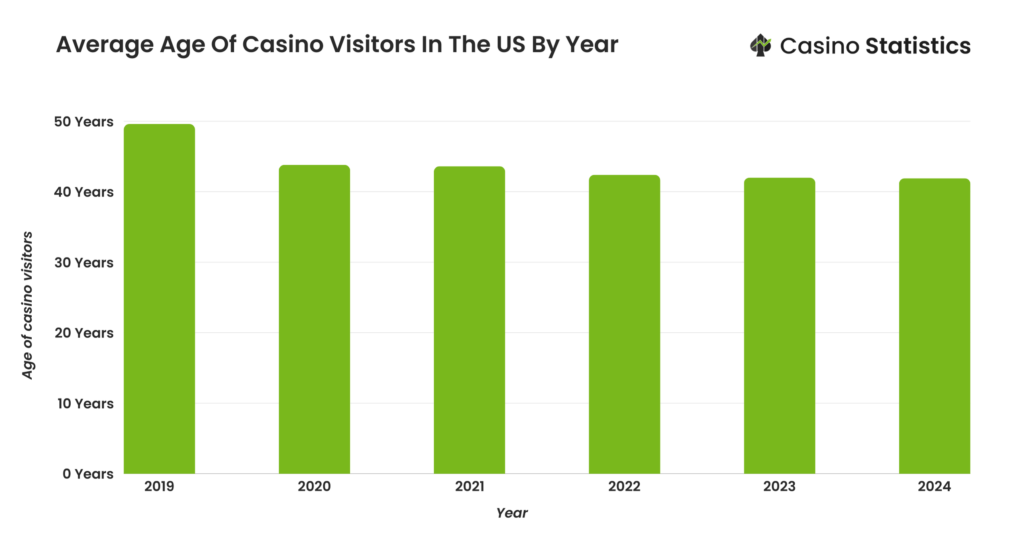
The following table displays the average age of casino visitors in the United States.
| Year | Average age of casino visitors in the United States |
|---|---|
| 2024 | 41.9 years |
| 2023 | 42 years |
| 2022 | 42.4 years |
| 2021 | 43.6 years |
| 2020 | 43.8 years |
| 2019 | 49.6 years |
Source: Statista
Casino Market Revenue
The revenue for U.S. casinos, excluding casino hotels, was estimated to reach $21.83 billion in 2024.
This marks a slight increase of about $0.24 billion compared to 2023.
After a significant drop in 2020 due to the pandemic, the market recovered quickly. Revenue increased by $0.48 billion in 2021 and continued to grow through 2022 and 2023. From 2020 to 2024, the industry has consistently expanded, with revenue climbing from $19.94 billion in 2020 to the expected $21.83 billion in 2024.
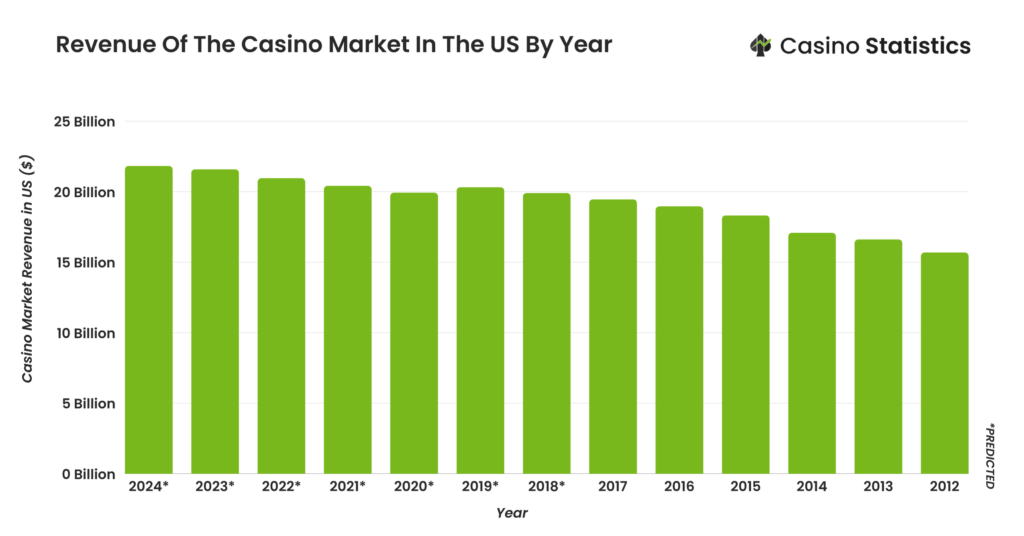
The following table displays the market revenue of the casino market in the United States by year:
| Year | Casino Market Revenue in US ($) |
|---|---|
| 2024* | 21.83 billion |
| 2023* | 21.59 billion |
| 2022* | 20.96 billion |
| 2021* | 20.42 billion |
| 2020* | 19.94 billion |
| 2019* | 20.32 billion |
| 2018* | 19.91 billion |
| 2017 | 19.46 billion |
| 2016 | 18.96 billion |
| 2015 | 18.32 billion |
| 2014 | 17.09 billion |
| 2013 | 16.62 billion |
| 2012 | 15.69 billion |
*-projected numbers
From 2013 to 2024, U.S. casino revenues have experienced notable growth, rising from $16.62 billion to $21.83 billion, which represents an overall increase of about 31.2% over the past decade.
Source: Statista
Casino Market Size
As of April 2024, the global casino and online gambling industry is valued at around $305.8 billion.
This includes gambling facilities offering games like table games, slot machines, and legal online casino games.
About two million employees are working across 5,000 casinos worldwide. In addition to gambling, these establishments often provide services such as dining, beverages, and lodging. The combination of gaming with hospitality services has become a hallmark of the casino experience.
The industry is rapidly expanding, with both physical casinos and online gambling platforms contributing to this growth. Online casinos, in particular, are becoming a key part of the market, allowing people to enjoy gambling from home.
This combination of land-based and online gambling continues to make the industry one of the most profitable sectors globally.
Source: Statista
Casino Statistics By States
Nevada has the highest number of Casinos in the United States in 2024 at 345.
Montana comes in second, with 171 casinos, followed by Louisiana with 136 casinos.
Other states with a notable presence of casinos include Oklahoma, California, and Florida, each contributing significantly to the total number of gambling establishments across the country.
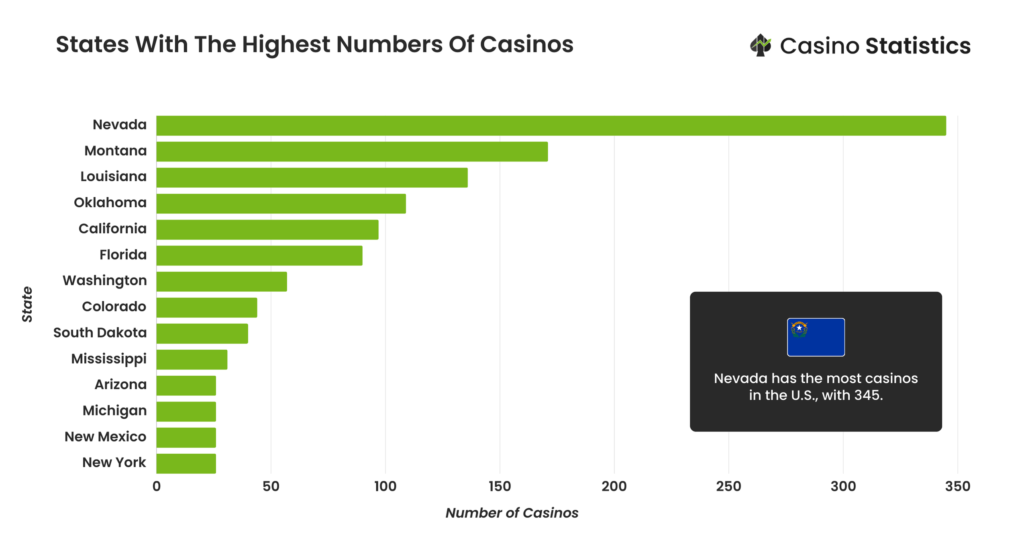
The following table displays the states with the highest number of casinos in the United States:
| State | Number of Casinos |
|---|---|
| Nevada | 345 |
| Montana | 171 |
| Louisiana | 136 |
| Oklahoma | 109 |
| California | 97 |
| Florida | 90 |
| Washington | 57 |
| Colorado | 44 |
| South Dakota | 40 |
| Mississippi | 31 |
| Arizona | 26 |
| Michigan | 26 |
| New Mexico | 26 |
| New York | 26 |
On the other hand, there are only two casinos each in seven states, while two states have three casinos.
Interestingly, there are seven states with no casinos at all. These states are Virginia, Vermont, Utah, Tennessee, New Hampshire, Hawaii, and Alaska.
Did You know? Gambling is banned in the State of Utah.
The following table displays the states with the lowest number of casinos in the United States as of 2024:
| State | Number of Casinos |
|---|---|
| Rhode Island | 2 |
| North Carolina | 2 |
| Maine | 2 |
| Kentucky | 2 |
| Georgia | 2 |
| Connecticut | 2 |
| Arkansas | 2 |
| Massachusetts | 3 |
| Delaware | 3 |
| Wyoming | 4 |
| South Carolina | 4 |
Source: World Population Review.
Casino Statistics By Country
According to the World Casino Directory, the United States has the highest number of casinos worldwide, with 2186 casinos.
Following the U.S., Serbia ranks second, with 522 casinos, and Romania holds third place with 448 casinos.
Other countries with a significant number of casinos include the Czech Republic, Italy, and Spain, each contributing notably to the global casino industry.
Here are further details about the countries with the highest number of casinos:
- United States: 2,186
- Serbia: 522
- Romania: 448
- Czech Republic: 401
- Italy: 388
- Spain: 340
- Bulgaria: 340
- United Kingdom: 308
- Canada: 221
- Slovakia: 204
- Mexico: 201
Besides, 17 countries worldwide have just one casino, and 21 countries have just 2 casinos.
Source: World Casino Directory
Around one in four people globally have tried gambling at some point in their lives.
The excitement, social aspect, and sense of escape make it appealing to many, leading them to return. However, some countries have much higher gambling participation rates, with over half of their populations engaging in the activity.
The United States, China, and Japan are among the leading countries in terms of gambling, collectively losing billions of dollars each year in gambling-related expenses.
Globally, the United States has the highest annual gross loss of $116.9 billion. In 2023, around 62% of Americans reported having gambled at some point during the year.
Despite gambling being illegal in mainland China, it has the second-highest gambling loss globally, amounting to $62.4 billion annually. While most forms of gambling are prohibited, China permits state-run lotteries, such as the Welfare Lottery and Sports Lottery, which were established in the late 20th century.
Although Japan‘s Criminal Code bans most forms of gambling, the country remains one of the largest gamblers in the world, with an annual loss of $24.1 billion in gambling in 2023.
The following table displays the countries with the highest loss in casino and other gambling activities in 2023:
| Rank | Country | Total Gambling Gross Loss |
|---|---|---|
| 1 | United States | $116.9 billion |
| 2 | China | $62.4 billion |
| 3 | Japan | $24.1 billion |
| 4 | Italy | $19 billion |
| 5 | Australia | $18.3 billion |
| 6 | United Kingdom | $18 billion |
| 7 | Canada | $12.4 billion |
| 8 | Germany | $11.2 billion |
| 9 | France | $10.4 billion |
| 10 | Spain | $8.9 billion |
Source: World Atlas
Online Casino Statistics
The online casino market was estimated to reach $35.01 billion in 2024.
The online casino market’s revenue worldwide is projected to grow by a CAGR of 5.56%, reaching an estimated value of $45.88 billion by 2029.
By 2029, the global number of online casino users is expected to reach 139.9 million, with user penetration rising from 3.0% in 2024 to 3.7% by 2029.
At the same time, the average revenue per user (ARPU) is anticipated to be $322.90, reflecting growing consumer spending in the online casino space.
Geographically, the United Kingdom was expected to generate the highest revenue, with a projected $6.47 billion in 2024. Meanwhile, Canada was anticipated to have the highest user penetration, with 35.6% of the population engaged in online casino gaming by 2029.
Source: Statista
The revenue of the online casino market in the United States was estimated to reach $6.29 billion in 2024.
At the same time, the average revenue per user in the market was expected to reach $194.80.
Further, the market is estimated to grow at a CAGR of 9.96% between 2024 and 2029 and is expected to reach $10.11 by the end of the forecast period.
The number of online casino players in the country is projected to reach 50.3 million by 2029, while user penetration is anticipated to grow from 9.4% in 2024 to 14.3% in 2029.
Source: Statista
Casino & Gambling Addiction Statistics Worldwide
Gambling disorder impacts nearly 16% of adults and over 26% of adolescents who participate in online casino games or slot machine activities.
Additionally, about 9% of adults and more than 16% of teens engaging in sports betting are affected by gambling addiction.
These numbers highlight that young people and regular users of online gambling platforms are at a higher risk of developing addiction.
Global data on gambling-related harm remains limited, but estimates indicate that around 1.2% of the world’s adult population is affected by gambling disorder.
Besides, around 450 million adults worldwide engage in “risk gambling,” which can harm finances, mental health, relationships, and work.
Source: USA Today, World Health Organization
Casino Trends for 2025
As we enter 2025, the casino gambling and betting industry is set to become more innovative and player-focused. Advancements in technology are shaping a dynamic landscape, transforming how players interact with games and services.
Here are some trends that will play a crucial role in the casino industry in 2025:
- Hyper-Personalized Experiences
Data analytics and artificial intelligence (AI) are driving a new level of personalization in online casinos and sportsbooks. Players can expect tailored game recommendations, customized bonuses, and targeted promotions designed to match their preferences, creating a uniquely engaging experience.
- AI in Gambling
AI is revolutionizing the industry by analyzing player behavior through predictive analytics, helping operators better understand and cater to their audience. It also plays a crucial role in promoting responsible gambling, with tools that identify patterns indicating potential problem behavior.
- Adoption of AR & VR in casinos
Virtual reality (VR) and augmented reality (AR) are transforming gaming by offering more realistic experiences. Using a VR headset, players can enter a virtual casino environment, where they can interact with other users and fully immerse themselves in the experience as though they were physically present. This technology is revolutionizing online gaming by directly delivering an interactive, lifelike casino atmosphere to players’ homes, enhancing the overall gaming experience.
- Mobile Gaming Dominance
With smartphones now a part of everyday life, mobile gaming is set to lead the gambling market. Enhanced mobile platforms ensure seamless access, allowing players to enjoy games anytime.
- Additional Industry Innovations
Beyond personalization and mobile gaming, the future includes:
- Esports betting: Capitalizing on the rising popularity of competitive gaming.
- Skill-based gaming: Offering more interactive and rewarding experiences for players.
- Cryptocurrency adoption: Enabling faster, secure, and decentralized transactions.
Conclusion: The Global Casino And Online Gambling Industry Is Valued At Approximately $305.8 Billion
With 8,108 casinos worldwide and 1,011 in the U.S., the industry is evolving rapidly. Online casinos are a key factor in this growth, with the global market eatimated to have reached $35.01 billion by 2024 and U.S. online casino revenue expected to hit $6.29 billion.
This surge is due to the rise of technologies like AI, mobile gaming, and virtual reality, which have enhanced user experiences, making gaming more personalized and immersive.
Additionally, addiction remains a significant concern, with nearly 16% of adults and over 26% of adolescents who engage in online casino games or slot machines struggling with gambling disorders.
Looking ahead, the casino industry’s economic impact and rapid growth are undeniable. However, the focus should now shift toward ensuring sustainable growth, addressing regulatory challenges, and protecting players. As the industry continues to evolve, it’s crucial for stakeholders to prioritize revenue growth and player well-being to maintain a responsible and healthy gambling environment.
